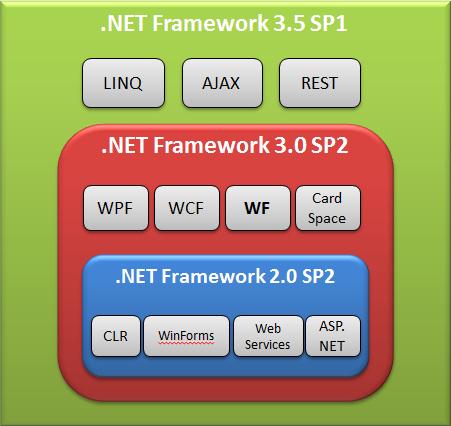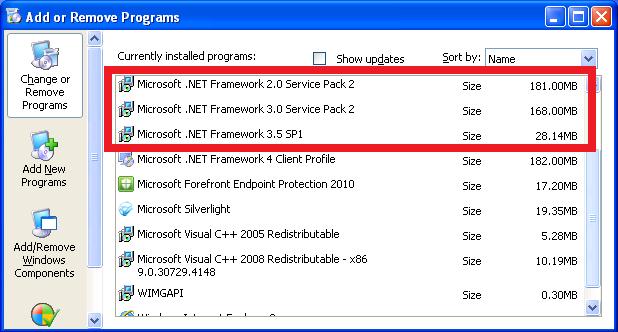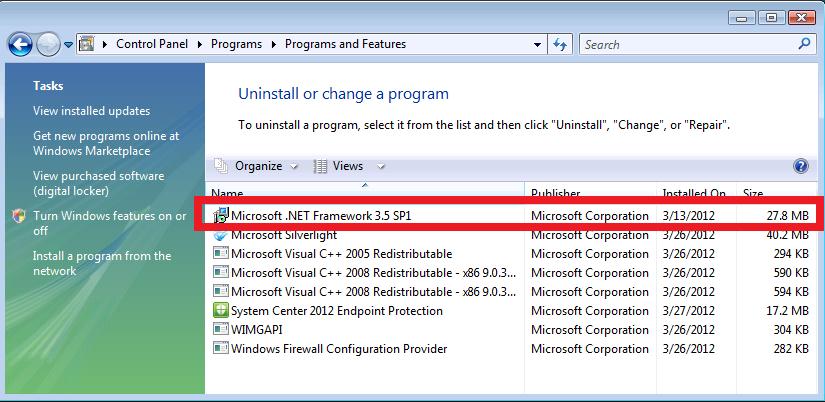INTRODUCTION
This article contains clarification on the support life cycle for the .NET Framework 3.5, the .NET Framework 3.0, and the .NET Framework 2.0.
Background
The .NET Framework 3.5, the .NET Framework 3.0, and the .NET Framework 2.0 were historically released as individual products on platforms in versions of Windows earlier than Windows 7 and Windows Server 2008 R2.
Each of these product versions are really layers of a feature stack. Internally, each layer contains mutually-exclusive components. So components in the .NET Framework 3.0 build on top of the .NET Framework 2.0, and components in the .NET Framework 3.5 build on top of both the .NET Framework 2.0 and the .NET Framework 3.0. This is shown in the following image:

One by-product of this architecture is that the .NET Framework 3.5 cannot function without the .NET Framework 2.0 and the .NET Framework 3.0 because there is no common language runtime (CLR) in the .NET Framework 3.5 layer. Therefore, when the .NET Framework 3.5 product is installed, this also installs the .NET Framework 2.0 Service Pack 1 (SP1) and the .NET Framework 3.0 SP1 products. Similarly, when the .NET Framework 3.5 SP1 product is installed, this also installs the .NET Framework 2.0 SP2 and .NET Framework 3.0 SP2 products. Customers who are running Windows XP or Windows Server 2003 can view these individual versions together with the corresponding updates under the Add or Remove Programs item in Control Panel:
On Windows Vista SP2 and Windows Server 2008 SP2, the .NET Framework 2.0 SP2 and the .NET Framework 3.0 SP2 are built into the operating system. Similarly, on Windows Vista SP1 and Windows Server 2008, the .NET Framework 2.0 SP1 and the .NET Framework 3.0 SP1 are built into the operating system. Therefore, customers only see the .NET Framework 3.5 under the Programs and Features item, as shown in the following image:
Support life cycle implications
Because the .NET Framework 3.5, the .NET Framework 3.0, and the .NET Framework 2.0 were released as independent product versions, each of these products have independent support lifecycles.
As discussed earlier in this article, the .NET Framework 3.5 cannot function without the .NET Framework 2.0 and the .NET Framework 3.0. In many cases, addressing functional issues or securing customers from security vulnerabilities for the .NET Framework 3.5 requires addressing issues in each of the three product layers. This can result in scenarios where the .NET Framework 3.5 is in support and requires an update that targets the underlying .NET Framework 2.0 or .NET Framework 3.0 product layers when the support life cycle documentation lists the underlying version as being out of support. One example of this is .NET Framework 3.5 SP1, which is currently supported. However, the .NET Framework 3.0 SP2 is documented as being out of support as of 7/12/2011.
In these cases, support for stand-alone installations of the .NET Framework 3.0 has expired. However, Microsoft will provide support for the .NET Framework 2.0 and .NET Framework 3.0 components for customers who install the .NET Framework 3.5 for as long as the .NET Framework 3.5 remains in support.
Additionally, because the .NET Framework 2.0 SP2 and the .NET Framework 3.0 SP2 are built into Windows Vista SP2 and Windows Server 2008 SP2, and the .NET Framework 2.0 SP1 and the .NET Framework 3.0 SP1 are built into Windows Vista SP1 and Windows Server 2008, those versions will be supported as part of the respective operating systems for as long as these .NET versions remain in support.
Note The .NET Framework 3.5 is only supported at the SP1 level together with the .NET Framework 2.0 SP2 and the .NET Framework 3.0 SP2. The original version of the .NET Framework 3.5 together with the .NET Framework 2.0 SP1 and the .NET Framework 3.0 SP1 are no longer in support.










